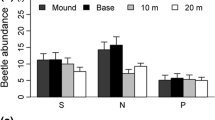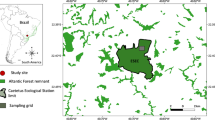Abstract
Large herbivores and termites are important functional groups in African savannahs. Both groups affect small mammals, which are also important determinants for savannah structure and function. Because vegetation on Macrotermes mounds are preferentially grazed by large herbivores, and mounds represent resource-rich distinct habitat patches for small mammals in relatively resource-poor savannahs, termite mounds are ideal sites for studies of how grazing by large mammals and productivity affect communities of small mammals. We conducted an experiment in Lake Mburo National Park, Uganda, with four treatments: large vegetated Macrotermes mounds (with and without large herbivores) and adjacent savannah areas (with and without large herbivores). We replicated the treatment blocks nine times and trapped small mammals regularly over a period of almost 2 years. Small mammal species assemblages differed considerably between mounds and savannah areas. Grazing had a substantial effect on small mammal species assemblages in the resource-poor savannah, but not in the relatively resource-rich termitaria. Small mammal species abundance, biomass, and richness were higher on termite mounds than adjacent savannah areas. Excluding large herbivores caused a major increase in species abundance, biomass, and richness both on savannah and termitaria. Herbaceous plant species evenness was an important determinant of the small mammal community. Small mammal biomass increased with high plant dominance, indicating that a few dominant plant species are important for biomass production of small mammals. Small mammal diversity was not related to any of the treatments, but increased with plant species evenness as well as richness. Fencing increased species dominance in the small mammal community on both savannah and termitaria, probably because competitive patterns shift from inter-guild (that is, between large and small mammals) to intra-guild (that is, between small mammals) when large mammals are excluded. The study highlights the complex interactions among large herbivores, termites, herbaceous plants, and small mammals in African savannahs. When studying the structure and function of small mammal communities it is therefore important to consider several coexisting functional groups.



Similar content being viewed by others
References
Anthony NM, Ribic CA, Bautz R, Garland T. 2005. Comparative effectiveness of Longworth and Sherman live traps. Wildl Soc Bull 33:1018–26.
Augustine DJ, McNaughton SJ, Frank DA. 2003. Feedbacks between soil nutrients and large herbivores in a managed savanna ecosystem. Ecol Appl 13:1325–37.
Averbeck C. 2002. Population ecology of Impala (Aepyceros melampus) and community-based wildlife conservation in Uganda. Ph.D Thesis, Technische Universität München, Universitätsbibliothek, Deutsche National Bibliothek, Frankfurt.
Beentje HJ, Cheek M. 2003. Flora of tropical East Africa: glossary. Lisse, The Netherlands: Balkema.
Blanchet FG, Legendre P, Borcard D. 2008. Forward selection of explanatory variables. Ecology 89:2623–32.
Bloesch U. 2008. Thicket clumps: a characteristic feature of the Kagera savanna landscape, East Africa. J Veg Sci 19:31–44.
Bråthen KA, Hagberg O. 2004. More efficient estimation of plant biomass. J Veg Sci 15:653–60.
Brown JS. 1989. Desert rodent community structure: a test of four mechanisms of coexistence. Ecol Monogr 59:1–20.
Delany MJ. 1975. The rodents of Uganda. British Museum (Natural History).
Dray S, Legendre P, Blanchet G. 2007. Packfor: forward selection with permutation. R package. Version 0.0-8. http://vegan.r-forge.r-project.org. Accessed 14 March 2012.
Fleming PA, Loveridge JP. 2003. Miombo woodland termite mounds: resource islands for small vertebrates? J Zool 259:161–8.
Grant CC, Scholes MC. 2006. The importance of nutrient hot-spots in the conservation and management of large wild mammalian herbivores in semi-arid savannas. Biol Conserv 130:426–37.
Haddad NM, Crutsinger GM, Gross K, Haarstad J, Knops JMH, Tilman D. 2009. Plant species loss decreases arthropod diversity and shifts trophic structure. Ecol Lett 12:1029–39.
Hagenah N, Prins HHT, Olff H. 2009. Effects of large herbivores on murid rodents in a South African savanna. J Trop Ecol 25:483–92.
Hillebrand H, Bennett DM, Cadotte MW. 2008. Consequences of dominance: a review of evenness effects on local and regional ecosystem processes. Ecology 89:1510–20.
Jones CG, Lawton JH, Shachak M. 1994. Organisms as ecosystem engineers. Oikos 69:373–86.
Keesing F. 1998. Impacts of ungulates on the demography and diversity of small mammals in central Kenya. Oecologia 116:381–9.
Keesing F. 2000. Cryptic Consumers and the Ecology of an African Savanna. BioScience 50:205–15.
Kingdon J. 2003. The kingdom field guide to African mammals. London: Christopher Helm, an imprint of A&C Black Publishers Ltd.
Konate S, Le Roux X, Tessier D, Lepage M. 1999. Influence of large termitaria on soil characteristics, soil water regime, and tree leaf shedding pattern in a West African savanna. Plant Soil 206:47–60.
Kotler BP, Brown JS. 1988. Environmental heterogeneity and the coexistence of desert rodents. Annu Rev Ecol Syst 19:281–307.
Kvålseth T. 1991. Note on biological diversity, evenness, and homogeneity measures. Oikos 62:123–7.
Legendre P, Gallagher ED. 2001. Ecologically meaningful transformations for ordination of species data. Oecologia 129:271–80.
Levick SR, Asner GP, Kennedy-Bowdoin T, Knapp DE. 2010. The spatial extent of termite influences on herbivore browsing in an African savanna. Biol Conserv 143:2462–7.
Loveridge JP, Moe SR. 2004. Termitaria as browsing hotspots for African megaherbivores in miombo woodland. J Trop Ecol 20:337–43.
McNaughton SJ. 1988. Mineral nutrition and spatial concentrations of African ungulates. Nature 334:343–5.
Mobæk R, Narmo AK, Moe SR. 2005. Termitaria are focal feeding sites for large ungulates in Lake Mburo National Park, Uganda. J Zool 267:97–102.
Moe SR, Mobæk R, Narmo AK. 2009. Mound building termites contribute to savanna vegetation heterogeneity. Plant Ecol 202:31–40.
Okullo P, Moe SR. 2012a. Large herbivores maintain termite-caused differences in herbaceous species diversity patterns. Ecology 93:2095–103.
Okullo P, Moe SR. 2012b. Termite activity, not grazing, is the main determinant of spatial variation in savanna herbaceous vegetation. J Ecol 100:232–41.
Pringle RM, Doak DF, Brody AK, Jocqué R, Palmer TM. 2010a. Spatial pattern enhances ecosystem functioning in an African savanna. PLoS Biol 8:e1000377.
Pringle RM, Palmer TM, Goheen JR, McCauley DJ, Keesing F. 2010b. Ecological importance of large herbivores in the Ewaso ecosystem. Smithson Contrib Zool 632:43–53.
Pringle RM, Young TP, Rubenstein DI, McCauley DJ. 2007. Herbivore-initiated interaction cascades and their modulation by productivity in an African savanna. Proc Natl Acad Sci 104:193–7.
R Development Core Team. 2011. R: a language and environment for statistical computing. Vienna: R Foundation for Statistical Computing.
Rannestad OT, Danielsen T, Moe SR, Stokke S. 2006. Adjacent pastoral areas support higher densities of wild ungulates during the wet season than the Lake Mburo National Park in Uganda. J Trop Ecol 22:675–83.
Scherber C, Eisenhauer N, Weisser WW, Schmid B, Voigt W, Fischer M, Schulze ED, Roscher C, Weigelt A, Allan E. 2010. Bottom-up effects of plant diversity on multitrophic interactions in a biodiversity experiment. Nature 468:553–6.
Simberloff D, Dayan T. 1991. The guild concept and the structure of ecological communities. Annu Rev Ecol Syst 22:115–43.
Smit R, Bokdam J, Den Ouden J, Olff H, Schot-Opschoor H, Schrijvers M. 2001. Effects of introduction and exclusion of large herbivores on small rodent communities. Plant Ecol 155:119–27.
Smith B, Wilson JB. 1996. A consumer’s guide to evenness indices. Oikos 76:70–82.
Van den Brink PJ, Ter Braak CJF. 1999. Principal response curves: analysis of time-dependent multivariate responses of biological community to stress. Environ Toxicol Chem 18:138–48.
Wallgren M, Skarpe C, Bergström R, Danell K, Granlund L, Bergström A. 2009. Mammal community structure in relation to disturbance and resource gradients in southern Africa. Afr J Ecol 47:20–31.
Yarnell R, Scott D, Chimimba C, Metcalfe D. 2007. Untangling the roles of fire, grazing and rainfall on small mammal communities in grassland ecosystems. Oecologia 154:387–402.
Acknowledgments
We thank James Nkwatsibwe, Patrick Bodo, Antonia Nyamukuru, Protase Rwaburindore, and Rose Kentalu for help in the field. Kimberly With and two anonymous referees provided valuable comments on preliminary drafts of this manuscript. We thank the Uganda Wildlife Authority for the research permit to work in Lake Mburo National Park. The study was funded by the Norwegian Research Council and the Norwegian State Educational Loan Fund for which we are very grateful.
Author information
Authors and Affiliations
Corresponding author
Additional information
Author Contributions
PO conceived the study, analyzed the data and wrote the article, PMKG participated in field data collection and writing the article, SRM conceived the study design and helped with data analysis and writing the article.
Rights and permissions
About this article
Cite this article
Okullo, P., Greve, P.M.K. & Moe, S.R. Termites, Large Herbivores, and Herbaceous Plant Dominance Structure Small Mammal Communities in Savannahs. Ecosystems 16, 1002–1012 (2013). https://doi.org/10.1007/s10021-013-9663-2
Received:
Accepted:
Published:
Issue Date:
DOI: https://doi.org/10.1007/s10021-013-9663-2




